Here's a working CodePen
the following code will return the point at a specific distance.
for this specific case the midpoint distance is total length / 2
call the main function like this, assuming our linestring array is stored in points
var totalLength = totalLen(points);
var midDistance = totalLength / 2;
var midPoint = getPointByDistance(points, midDistance)
##Javascript
myData = {
"type": "FeatureCollection",
"features": [{
"type": "Feature",
"properties": {},
"geometry": {
"type": "LineString",
"coordinates": [
[
2.6806640625,
46.437856895024204
],
[
4.7021484375,
50.20503326494332
],
[
13.271484375,
47.010225655683485
],
[
17.2265625,
52.855864177853974
]
]
}
}]
}
var points = myData.features[0].geometry.coordinates
var totalLength = totalLen(points);
var midDistance = totalLength / 2;
var midPoint = getPointByDistance(points, midDistance)
alert ("midPoint = " + midPoint[0] + ", " + midPoint[1])
// main function
function getPointByDistance(pnts, distance) {
var cl = 0;
var ol;
var result;
pnts.forEach(function(point, i, points) {
ol = cl;
cl += i ? lineLen([points[i-1], point]) : 0;
if (distance <= cl && distance > ol){
var dd = distance - ol;
result = pntOnLine([points[i-1], point], dd);
}
});
return result
};
// returns a point on a single line (two points) using distance // line=[[x0,y0],[x1,y1]]
function pntOnLine(line, distance) {
t = distance / lineLen(line)
xt = (1 - t) * line[0][0] + (t * line[1][0])
yt = (1 - t) * line[0][1] + (t * line[1][1])
return [xt, yt]
};
// returns the total length of a linestring (multiple points) // pnts=[[x0,y0],[x1,y1],[x2,y2],...]
function totalLen(pnts) {
var tl = 0;
pnts.forEach(function(point, i, points) {
tl += i ? lineLen([points[i - 1], point]) : 0;
});
return tl;
};
// returns the length of a line (two points) // line=[[x0,y0],[x1,y1]]
function lineLen(line) {
var xd = line[0][0] - line[1][0];
var yd = line[0][1] - line[1][1];
return Math.sqrt(xd * xd + yd * yd);
};
##Explanation
1. we find the total length of the linestring:
- function
lineLen() calculates the length of a single line.
- function
totalLen() loops through the lines and calculates the total length.

*source and credits here (Igor Šarčević)
2. the distance of midpoint is total length / 2:
now that we have the wanted distance we loop through lines and check distance of this line-startpoint and this line-endpoint and see if midpoint distance is between them.
once we have the single line that we know our midpoint is on we calculate it's distance from this line-startpoint (total length - line-startpoint distance)
now we use this formula (function pntOnLine()) to find xt,yt (wanted midpoint)

*credits to Sen Jacob.
##Visualization
I included an HTML5 canvas to draw (visualize) the linestring and midpoint, you don't have to include them. but they're useful if you want to test the code and see the result live
// Just for visualizing on canvas (not needed)
var canvas = document.getElementById("myCanvas");
var ctx = canvas.getContext('2d');
drawLine(points);
//
ctx.beginPath();
ctx.arc(midPoint[0], midPoint[1], 2, 0, 2 * Math.PI);
ctx.closePath();
ctx.fillStyle = "red";
ctx.fill();
//
function drawLine(pnts) {
pnts.forEach(function(point, i, points) {
if (i === 0) {
ctx.beginPath();
ctx.moveTo(point[0], point[1]);
} else {
ctx.lineTo(point[0], point[1]);
}
if (i === points.length - 1) {
ctx.stroke();
}
});
}

